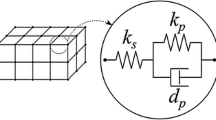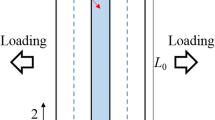Abstract
An illustrative documentation of some standard experimental tests of electro-active VHB 4910 polymer under application of purely mechanical and electro-mechanically coupled loadings is presented. VHB 4910 is a very soft polymer that has potential applications as an electro-active polymer in the production of different types of actuators and sensors. The time-dependent viscoelastic phenomenon is ideal in polymers. Therefore, experiments with electro-mechanically coupled loads were conducted considering some standard tests that were usually used for a viscoelastic polymeric material characterization, i.e. loading-unloading tests, single-step relaxation tests, and multi-step relaxation tests. In all experimental cases, the polymer samples were pre-stretched up to several hundred per cent to make them thin enough initially so that the application of the electro-mechanically coupled load can show its effect to a larger extend. The pre-stretched samples were then subjected to various amounts of mechanical as well as coupled deformations at different strain rates. The data produced from several loading-unloading tests, single-step relaxation tests, and multi-step relaxation tests show that the electric loading has profound effect in the time-dependent behaviour of the electro-active VHB 4910 polymer. The data set either from single-step relaxation tests or multi-step relaxation tests can be used to identify electro-viscoelastic parameters for a suitable constitutive model that can capture electro-mechanically coupled behaviours of VHB 4910. For validation, loading-unloading cyclic tests data can be utilized.
Similar content being viewed by others
References
Ask, A., Menzel, A., Ristinma, M.: Phenomenological modeling of viscous electrostrictive polymers. Int. J. Non-Linear Mech. 47(2), 156–165 (2012)
Vu, D.K., Steinmann, P., Possart, G.: Numerical modeling of non-linear electroelasticity. Int. J. Numer. Methods Eng. 70, 685–704 (2007)
Vu, D.K., Steinmann, P.: A 2-D coupled BEM-FEM simulation of electro-elastostatics at large strain. Comput. Methods Appl. Mech. Eng. 199, 1124–1133 (2010)
Ask, A., Menzel, A., Ristinma, M.: Electrostriction in electro-viscoelastic polymers. Mech. Mater. 50, 9–21 (2012)
Büeschel, A., Klinkel, K., Wagner, W.: Dielectric elastomers–numerical modeling of nonlinear visco-electroelasticity. Int. J. Numer. Methods Eng. 93, 834–856 (2013)
Hossain, M., Vu, D.K., Steinmann, P.: Experimental study and numerical modelling of VHB 4910 polymer. Comput. Mater. Sci. 59, 65–74 (2012)
Hossain, M., Steinmann, P.: More hyperelastic models for rubber-like materials: consistent tangent operators and comparative study. J. Mech. Behav. Mater. 22(1-2), 27–50 (2013)
Wissler, M., Mazza, E.: Mechanical behaviour of an acrylic elastomer used in dielectric elastomer actuators. Sensors Actuators A 134, 494–504 (2007)
Gao, Z., Tuncer, A., Cuitino, A.H.: Modeling and simulation of the coupled mechanical-electrical response of soft solids. Int. J. Plast. 27(10), 1459–1470 (2011)
Diaconu, I., Dorohoi, D.O., Ciobanu, C.: Electromechanical response of polyurethane films with different thickness. Romanian J. Phys. 53(1–2), 91–97 (2008)
Qiang, J., Chen, H., Li, B.: Experimental study on the dielectric properties of polyacrylate dielectric elastomer. Smart Mater. Struct. 21, 1–9 (2012)
Ask, A., Denzer, R., Menzel, A., Ristinma, M.: Inverse-motion-based form finding for quasi-incompressible finite electroelasticity. Int. J. Numer. Methods Eng. 94(6), 554–572 (2013)
Ma, W., Cross, L.E.: An experimental investigation of electromechanical response in a dielectric acrylic elastomer. Appl. Phys. A 78, 1201–1204 (2004)
Michel, S., Zhang, Z.Q., Wissler, M., Löewe, C., Kovocs, G.: A comparison between silicone and acrylic elastomers as dielectric materials in electroactive polymer actuators. Polym. Int. 59, 391–399 (2010)
Amin, A.F.M.S., Lion, A., Sekita, A., Okui, Y.: Nonlinear dependence of viscosity in modeling the rate-dependent response of natural and high damping rubbers in compression and shear: experimental identification and numerical verification. Int. J. Plast. 22, 1610–1667 (2006)
Bergström, J.S., Boyce, M.C.: Constitutive modeling of the large strain time-dependent behavior of elastomers. J. Mech. Phys. Solids 46, 931–954 (1998)
Johlitz, M., Steeb, H., Diebels, S., Chatzouridou, A., Batal, J., Possart, W.: Experimental and theoretical investigation of nonlinear viscoelastic polyurethane systems. J. Mater. Sci. 42, 9894–9904 (2007)
Author information
Authors and Affiliations
Corresponding author
Rights and permissions
About this article
Cite this article
Hossain, M., Vu, D.K. & Steinmann, P. A comprehensive characterization of the electro-mechanically coupled properties of VHB 4910 polymer. Arch Appl Mech 85, 523–537 (2015). https://doi.org/10.1007/s00419-014-0928-9
Received:
Accepted:
Published:
Issue Date:
DOI: https://doi.org/10.1007/s00419-014-0928-9




